玩具教学设计(Toy teaching design)
- 格式:doc
- 大小:26.01 KB
- 文档页数:14
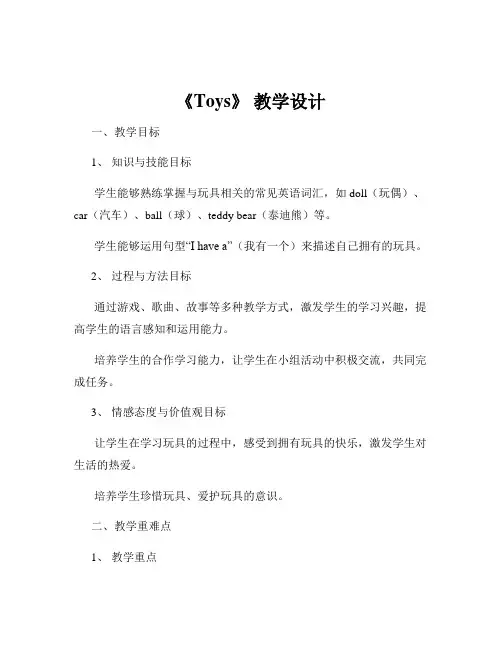
《Toys》教学设计一、教学目标1、知识与技能目标学生能够熟练掌握与玩具相关的常见英语词汇,如 doll(玩偶)、car(汽车)、ball(球)、teddy bear(泰迪熊)等。
学生能够运用句型“I have a”(我有一个)来描述自己拥有的玩具。
2、过程与方法目标通过游戏、歌曲、故事等多种教学方式,激发学生的学习兴趣,提高学生的语言感知和运用能力。
培养学生的合作学习能力,让学生在小组活动中积极交流,共同完成任务。
3、情感态度与价值观目标让学生在学习玩具的过程中,感受到拥有玩具的快乐,激发学生对生活的热爱。
培养学生珍惜玩具、爱护玩具的意识。
二、教学重难点1、教学重点掌握玩具相关的英语词汇。
熟练运用句型“I have a”进行表达。
2、教学难点部分词汇的发音,如“teddy bear”中“bear”的发音。
如何引导学生在实际情境中自然地运用所学句型进行交流。
三、教学方法1、情景教学法创设玩具商店的情景,让学生在真实的场景中学习和运用英语。
2、游戏教学法开展“猜玩具”“玩具接力”等游戏,增加学习的趣味性,巩固所学知识。
3、歌曲教学法教唱与玩具相关的英语歌曲,帮助学生记忆词汇和句型。
4、小组合作学习法组织学生进行小组活动,共同完成任务,培养合作精神和交流能力。
四、教学过程1、导入(5 分钟)播放一段关于玩具的动画短片,引起学生的兴趣。
提问学生:“What can you see in the video?”(在视频中你能看到什么?)引导学生回答出一些玩具的名称。
2、词汇学习(15 分钟)展示各种玩具的图片,依次教授新单词:doll, car, ball, teddy bear 等。
带领学生跟读单词,纠正发音。
进行单词认读练习,如闪卡游戏、单词配对等。
3、句型学习(15 分钟)拿着一个玩具,说:“I have a doll” 并让学生模仿。
让学生用自己的玩具或图片,练习说:“I have a”句型。
小组内互相交流,展示练习成果。
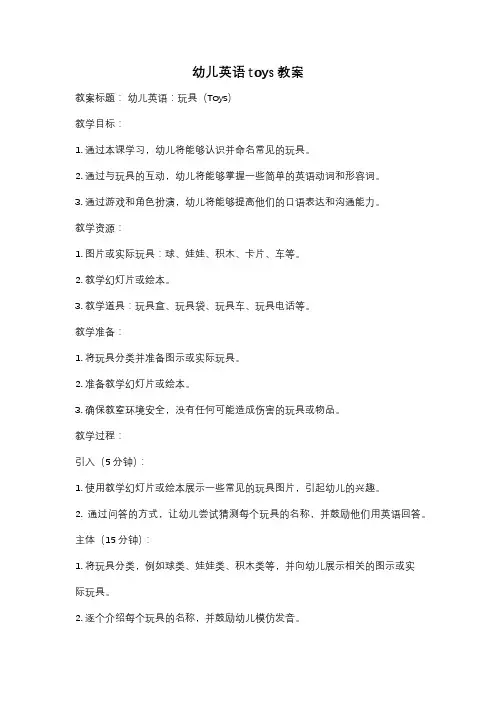
幼儿英语toys教案教案标题:幼儿英语:玩具(Toys)教学目标:1. 通过本课学习,幼儿将能够认识并命名常见的玩具。
2. 通过与玩具的互动,幼儿将能够掌握一些简单的英语动词和形容词。
3. 通过游戏和角色扮演,幼儿将能够提高他们的口语表达和沟通能力。
教学资源:1. 图片或实际玩具:球、娃娃、积木、卡片、车等。
2. 教学幻灯片或绘本。
3. 教学道具:玩具盒、玩具袋、玩具车、玩具电话等。
教学准备:1. 将玩具分类并准备图示或实际玩具。
2. 准备教学幻灯片或绘本。
3. 确保教室环境安全,没有任何可能造成伤害的玩具或物品。
教学过程:引入(5分钟):1. 使用教学幻灯片或绘本展示一些常见的玩具图片,引起幼儿的兴趣。
2. 通过问答的方式,让幼儿尝试猜测每个玩具的名称,并鼓励他们用英语回答。
主体(15分钟):1. 将玩具分类,例如球类、娃娃类、积木类等,并向幼儿展示相关的图示或实际玩具。
2. 逐个介绍每个玩具的名称,并鼓励幼儿模仿发音。
3. 引导幼儿描述每个玩具的特点和用途,例如“这是一只红色的球,我们可以踢它”。
4. 利用教学道具和实际玩具,让幼儿进行角色扮演和模仿游戏,例如“我是一个玩具店的售货员,你是顾客,请问你想要什么玩具?”5. 引导幼儿使用英语动词和形容词来描述他们正在进行的游戏,例如“我在玩积木,我正在堆高楼”。
巩固(10分钟):1. 制作一个玩具盒或玩具袋,将不同的玩具放进去。
2. 让每个幼儿轮流从盒子或袋子里取出一个玩具,并用英语说出它的名称。
3. 鼓励幼儿描述他们最喜欢的玩具,并与同伴分享。
结束(5分钟):1. 回顾今天学习的内容,让幼儿总结他们所学到的玩具名称和描述。
2. 鼓励幼儿用英语与家长或朋友分享他们今天的学习成果。
教学扩展:1. 鼓励幼儿在家庭环境中使用英语与家长一起玩玩具。
2. 带领幼儿参观玩具店,让他们用英语与售货员交流。
3. 利用音乐和歌曲,帮助幼儿巩固所学的玩具名称和描述。
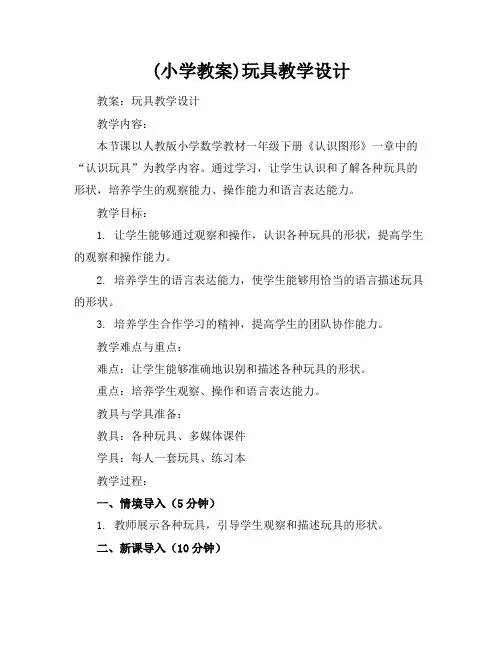
(小学教案)玩具教学设计教案:玩具教学设计教学内容:本节课以人教版小学数学教材一年级下册《认识图形》一章中的“认识玩具”为教学内容。
通过学习,让学生认识和了解各种玩具的形状,培养学生的观察能力、操作能力和语言表达能力。
教学目标:1. 让学生能够通过观察和操作,认识各种玩具的形状,提高学生的观察和操作能力。
2. 培养学生的语言表达能力,使学生能够用恰当的语言描述玩具的形状。
3. 培养学生合作学习的精神,提高学生的团队协作能力。
教学难点与重点:难点:让学生能够准确地识别和描述各种玩具的形状。
重点:培养学生观察、操作和语言表达能力。
教具与学具准备:教具:各种玩具、多媒体课件学具:每人一套玩具、练习本教学过程:一、情境导入(5分钟)1. 教师展示各种玩具,引导学生观察和描述玩具的形状。
二、新课导入(10分钟)1. 教师引导学生观察教材中的玩具图片,让学生说一说每个玩具的形状。
2. 教师讲解玩具形状的名称和特征,引导学生认识和理解。
三、课堂练习(10分钟)1. 教师发放练习本,让学生根据教材中的玩具图片,画出对应的形状。
2. 学生完成后,教师进行点评和指导。
四、小组合作(10分钟)五、课堂小结(5分钟)1. 教师引导学生回顾本节课所学的内容,让学生说一说自己最喜欢的玩具及其形状。
板书设计:认识玩具1. 玩具形状:圆形、方形、三角形、梯形等2. 玩具特征:大小、颜色、材料等作业设计:1. 请学生每人画出一个自己喜欢的玩具,并写一写该玩具的形状特征。
课后反思及拓展延伸:课后反思:在本节课中,学生对玩具的形状有了更深入的认识,观察和操作能力得到了提高。
但在课堂练习环节,部分学生对形状的识别和描述仍有困难,需要在今后的教学中加强指导和练习。
拓展延伸:1. 邀请家长参与课堂,让学生在家中与家长一起收集各种玩具,观察和描述玩具的形状,增进亲子关系。
2. 组织学生参观玩具展览,让学生在实际环境中感受和认识各种玩具的形状。
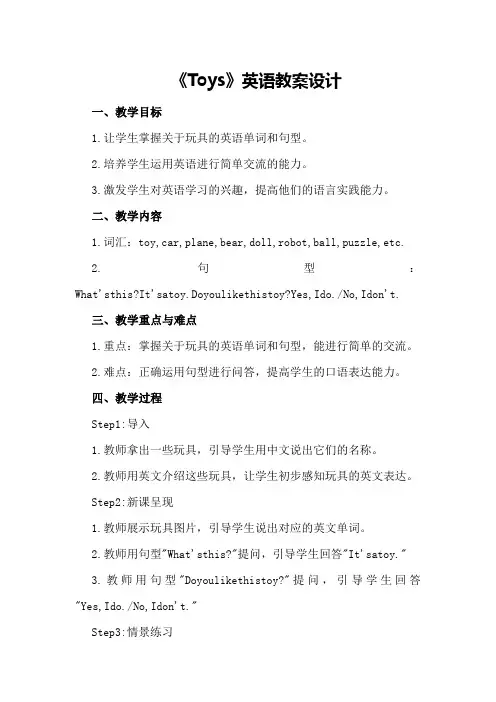
《Toys》英语教案设计一、教学目标1.让学生掌握关于玩具的英语单词和句型。
2.培养学生运用英语进行简单交流的能力。
3.激发学生对英语学习的兴趣,提高他们的语言实践能力。
二、教学内容1.词汇:toy,car,plane,bear,doll,robot,ball,puzzle,etc.2.句型:What'sthis?It'satoy.Doyoulikethistoy?Yes,Ido./No,Idon't.三、教学重点与难点1.重点:掌握关于玩具的英语单词和句型,能进行简单的交流。
2.难点:正确运用句型进行问答,提高学生的口语表达能力。
四、教学过程Step1:导入1.教师拿出一些玩具,引导学生用中文说出它们的名称。
2.教师用英文介绍这些玩具,让学生初步感知玩具的英文表达。
Step2:新课呈现1.教师展示玩具图片,引导学生说出对应的英文单词。
2.教师用句型"What'sthis?"提问,引导学生回答"It'satoy."3.教师用句型"Doyoulikethistoy?"提问,引导学生回答"Yes,Ido./No,Idon't."Step3:情景练习1.教师将学生分成小组,每组选出一个代表进行角色扮演。
2.代表用句型"What'sthis?"和"Doyoulikethistoy?"进行问答,其他组员回答。
3.每组轮流进行,直到所有组员都有机会练习。
Step4:小组活动1.教师给每组发放一些玩具图片和单词卡片。
2.学生需要在小组内用英文讨论这些玩具,并用句型进行问答。
3.教师巡回指导,纠正学生的发音和语法错误。
1.教师邀请几名学生分享他们在小组活动中的表现,包括用到的单词和句型。
3.教师提出一些拓展问题,如:"Whattoydoyoulikebest?""Whydoyoulikeit?",让学生进行思考并回答。
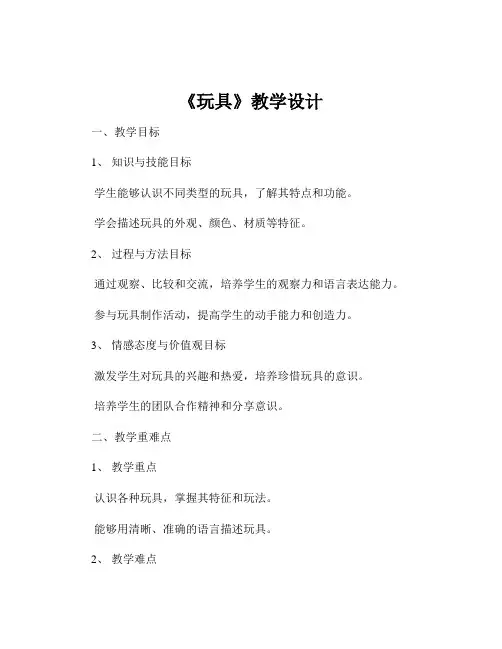
《玩具》教学设计一、教学目标1、知识与技能目标学生能够认识不同类型的玩具,了解其特点和功能。
学会描述玩具的外观、颜色、材质等特征。
2、过程与方法目标通过观察、比较和交流,培养学生的观察力和语言表达能力。
参与玩具制作活动,提高学生的动手能力和创造力。
3、情感态度与价值观目标激发学生对玩具的兴趣和热爱,培养珍惜玩具的意识。
培养学生的团队合作精神和分享意识。
二、教学重难点1、教学重点认识各种玩具,掌握其特征和玩法。
能够用清晰、准确的语言描述玩具。
2、教学难点理解玩具在儿童成长中的作用和意义。
培养学生的创新思维和动手能力,设计并制作出独特的玩具。
三、教学方法1、直观教学法通过展示实物玩具、图片、视频等,让学生直观地感受玩具的多样性和趣味性。
2、讨论法组织学生进行小组讨论,分享自己喜欢的玩具以及玩玩具的经历,促进学生之间的交流与合作。
3、实践操作法安排学生参与玩具制作活动,亲身体验制作玩具的过程,培养动手能力和创造力。
四、教学过程1、导入(3 分钟)展示一些常见的玩具,如玩具车、毛绒玩具、积木等,引起学生的兴趣。
提问:同学们,你们都喜欢玩玩具吗?今天我们就一起来走进玩具的世界。
2、认识玩具(7 分钟)教师展示不同类型的玩具,如益智玩具、运动玩具、角色扮演玩具等,并简单介绍它们的特点和功能。
学生分组观察玩具,讨论它们的外观、颜色、材质等特征。
每组派代表上台介绍自己小组观察的玩具。
3、玩具的作用(10 分钟)播放一段关于儿童玩玩具的视频,引导学生思考玩具对儿童成长的作用。
学生自由发言,分享自己的想法。
教师总结:玩具可以帮助儿童发展智力、提高动手能力、培养想象力和创造力,还可以增强儿童的社交能力和情感表达能力。
4、描述玩具(10 分钟)教师拿出一个玩具,示范如何用准确、生动的语言描述它的特征和玩法。
学生选择自己喜欢的玩具,用几句话向同桌描述它。
请几位学生上台向全班同学描述自己的玩具,其他同学认真倾听并评价。
5、玩具制作(20 分钟)教师展示一些简单的玩具制作材料,如纸、彩笔、剪刀、胶水等,介绍制作方法和注意事项。

《玩具》教学设计一、教学目标1、让学生了解不同类型的玩具,包括传统玩具和现代玩具。
2、引导学生观察玩具的特点和功能,培养学生的观察力和描述能力。
3、鼓励学生分享自己与玩具的故事,增强学生的语言表达和情感交流能力。
4、激发学生对玩具的创造力和想象力,尝试自己设计或改进玩具。
二、教学重难点1、重点认识各类玩具,掌握其特点和玩法。
能够清晰、生动地描述自己喜欢的玩具。
2、难点培养学生的创新思维,设计出有创意的玩具。
引导学生从玩具中体会到乐趣和情感价值。
三、教学方法讲授法、讨论法、实践法、展示法四、教学过程1、导入(5 分钟)同学们,今天老师带来了一个神秘的盒子,你们猜猜里面装的是什么?(引起学生的好奇心)老师慢慢地从盒子里拿出一个玩具小汽车,问:“这是什么呀?你们喜欢吗?”2、认识玩具(10 分钟)老师通过 PPT 展示各种玩具的图片,如毛绒玩具、积木、拼图、玩偶等,一边展示一边介绍它们的名称和特点。
让学生举手发言,说一说自己还见过哪些玩具。
3、观察玩具(10 分钟)把学生分成小组,每个小组发放一个玩具,让学生仔细观察玩具的形状、颜色、材质等。
小组讨论:这个玩具怎么玩?有什么特别的地方?每个小组选一个代表,向全班同学介绍自己小组观察的玩具。
4、分享玩具故事(15 分钟)老师讲述自己小时候与一个玩具熊的故事:“老师小时候有一个特别喜欢的玩具熊,每天晚上都要抱着它睡觉。
有一次,我不小心把它弄脏了,还哭了好久呢。
”(引起学生的共鸣)让学生们也来讲讲自己与玩具之间的难忘故事,可以是开心的、伤心的或者有趣的。
5、创意设计玩具(20 分钟)老师引导:“现在,我们来当一回小小设计师,设计一个属于自己的玩具吧!”给学生发放纸和笔,让他们画出自己设计的玩具,并在旁边写上玩具的名称、功能和玩法。
邀请学生上台展示自己的设计作品,并向大家介绍。
6、总结(5 分钟)今天我们认识了很多玩具,也听到了很多有趣的玩具故事,还设计了自己的玩具。
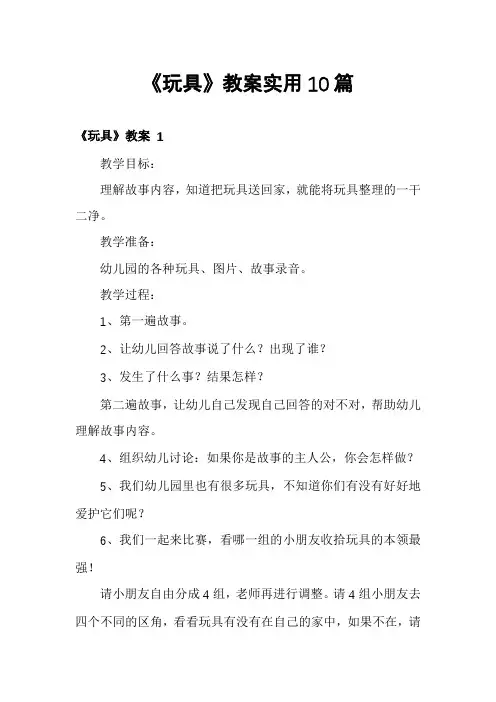
《玩具》教案实用10篇《玩具》教案 1教学目标:理解故事内容,知道把玩具送回家,就能将玩具整理的一干二净。
教学准备:幼儿园的各种玩具、图片、故事录音。
教学过程:1、第一遍故事。
2、让幼儿回答故事说了什么?出现了谁?3、发生了什么事?结果怎样?第二遍故事,让幼儿自己发现自己回答的对不对,帮助幼儿理解故事内容。
4、组织幼儿讨论:如果你是故事的主人公,你会怎样做?5、我们幼儿园里也有很多玩具,不知道你们有没有好好地爱护它们呢?6、我们一起来比赛,看哪一组的小朋友收拾玩具的本领最强!请小朋友自由分成4组,老师再进行调整。
请4组小朋友去四个不同的区角,看看玩具有没有在自己的家中,如果不在,请送玩具回家。
活动反思:一、老师抛出的问题一定是要由浅入深的,此外,没有问题老师一定要在最后小结一下,这样才能加深幼儿的印象。
本次活动,我抛出问题之后,没有很好地将问题进行小结。
同时,我抛出问题之后,没有牢牢抓住问题的核心,这样幼儿在回答的时候更不清楚老师问题的核心了。
所以,当小朋友的答案与老师问题的核心不匹配的时候,我应该进行一个追问,而不是一语带过。
二、第一遍故事与第二遍故事的出现雷同。
其实,第一遍故事的时候,图片可以不出示,这样在讲述第二遍故事的时候,出示图片才能吸引幼儿的注意力。
此外,第二遍故事之后,我应该针对问题进行深入挖掘,而不是泛泛而谈。
在重复故事之前,我可以将问题先抛给小朋友,让小朋友带着问题去听故事。
这样,语言能力强的小朋友可能还会复述故事中的一句话、一个新词汇。
三、请小朋友收拾玩具之前,一定要让他们有任务感,而不是很茫然地,不知道老师的要求。
同时,我可以尝试着让小朋友自己分组,这样就可以在点滴中提高小朋友的能力《玩具》教案 2(第一课时)教学目标:1、通过学生对玩具的采访调查活动,了解玩具的发现变化、玩具的种类与特点、保护和收藏玩具的方法。
2、通过搜集玩具,发展、交流玩具的特点与玩法、收藏的方法等活动,培养学生的'观察能力和表达能力。
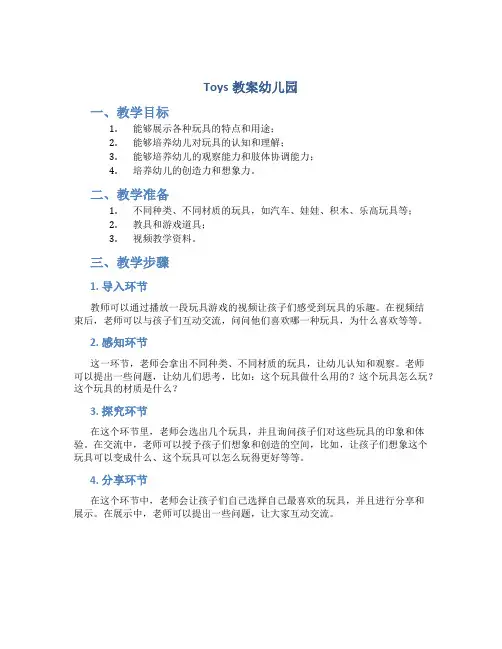
Toys教案幼儿园
一、教学目标
1.能够展示各种玩具的特点和用途;
2.能够培养幼儿对玩具的认知和理解;
3.能够培养幼儿的观察能力和肢体协调能力;
4.培养幼儿的创造力和想象力。
二、教学准备
1.不同种类、不同材质的玩具,如汽车、娃娃、积木、乐高玩具等;
2.教具和游戏道具;
3.视频教学资料。
三、教学步骤
1. 导入环节
教师可以通过播放一段玩具游戏的视频让孩子们感受到玩具的乐趣。
在视频结
束后,老师可以与孩子们互动交流,问问他们喜欢哪一种玩具,为什么喜欢等等。
2. 感知环节
这一环节,老师会拿出不同种类、不同材质的玩具,让幼儿认知和观察。
老师
可以提出一些问题,让幼儿们思考,比如:这个玩具做什么用的?这个玩具怎么玩?这个玩具的材质是什么?
3. 探究环节
在这个环节里,老师会选出几个玩具,并且询问孩子们对这些玩具的印象和体验。
在交流中,老师可以授予孩子们想象和创造的空间,比如,让孩子们想象这个玩具可以变成什么、这个玩具可以怎么玩得更好等等。
4. 分享环节
在这个环节中,老师会让孩子们自己选择自己最喜欢的玩具,并且进行分享和
展示。
在展示中,老师可以提出一些问题,让大家互动交流。
四、教学反思
通过这个教学活动,幼儿能够对各种玩具的特点和用途有更深入的认知,也能够培养幼儿的观察能力和肢体协调能力。
同时,活动也为幼儿们提供了一个表达自我的机会,培养了孩子们的想象力和创造力。
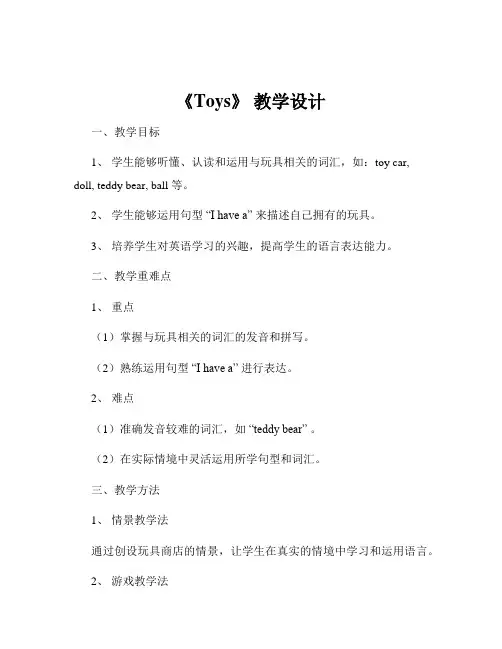
《Toys》教学设计一、教学目标1、学生能够听懂、认读和运用与玩具相关的词汇,如:toy car, doll, teddy bear, ball 等。
2、学生能够运用句型“I have a” 来描述自己拥有的玩具。
3、培养学生对英语学习的兴趣,提高学生的语言表达能力。
二、教学重难点1、重点(1)掌握与玩具相关的词汇的发音和拼写。
(2)熟练运用句型“I have a” 进行表达。
2、难点(1)准确发音较难的词汇,如“teddy bear” 。
(2)在实际情境中灵活运用所学句型和词汇。
三、教学方法1、情景教学法通过创设玩具商店的情景,让学生在真实的情境中学习和运用语言。
2、游戏教学法设计有趣的游戏,如猜谜语、找玩具等,激发学生的学习兴趣和积极性。
3、小组合作学习法组织学生进行小组合作,共同完成学习任务,培养学生的合作意识和交流能力。
四、教学过程(一)导入(5 分钟)1、播放一首与玩具相关的英文歌曲,如《Toys, Toys》,让学生在欢快的音乐中感受玩具的主题。
2、展示一些玩具的图片,问学生:“What can you see?” 引导学生回答出玩具的名称,从而引出本节课的主题“Toys” 。
(二)词汇学习(15 分钟)1、依次展示 toy car, doll, teddy bear, ball 等玩具的图片,并教学生认读这些单词。
采用自然拼读法,帮助学生掌握单词的发音。
带领学生多读几遍,纠正发音。
2、玩猜谜语游戏教师描述一个玩具的特征,让学生猜是什么玩具。
例如:“It's soft It has two big eyes It's brown What is it?” (学生回答:“Teddy bear” )(三)句型学习(15 分钟)1、教师拿出一个玩具汽车,说:“I have a toy car” 并让学生模仿。
2、让学生拿出自己的玩具,用句型“I have a” 向同桌介绍自己拥有的玩具。
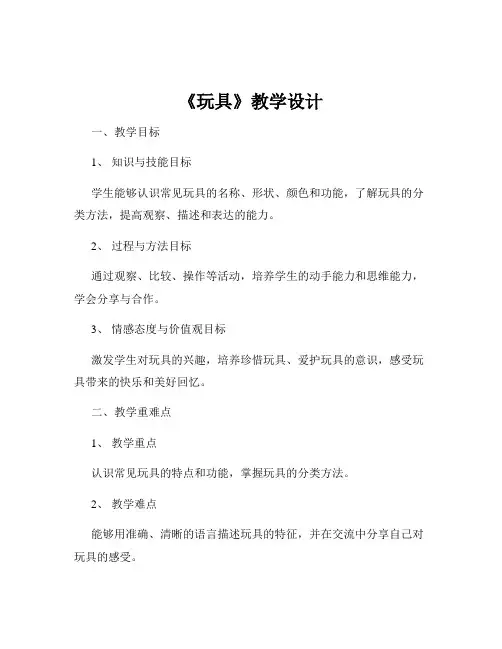
《玩具》教学设计一、教学目标1、知识与技能目标学生能够认识常见玩具的名称、形状、颜色和功能,了解玩具的分类方法,提高观察、描述和表达的能力。
2、过程与方法目标通过观察、比较、操作等活动,培养学生的动手能力和思维能力,学会分享与合作。
3、情感态度与价值观目标激发学生对玩具的兴趣,培养珍惜玩具、爱护玩具的意识,感受玩具带来的快乐和美好回忆。
二、教学重难点1、教学重点认识常见玩具的特点和功能,掌握玩具的分类方法。
2、教学难点能够用准确、清晰的语言描述玩具的特征,并在交流中分享自己对玩具的感受。
三、教学方法讲授法、直观演示法、讨论法、实践操作法四、教学准备1、教师准备各种常见玩具的实物或图片、多媒体课件、分类卡片等。
2、学生准备自己最喜欢的一件玩具五、教学过程(一)导入新课通过播放一段小朋友们在玩具店中挑选玩具的视频,引导学生观察并思考:“视频中都有哪些玩具?你最喜欢哪一个?”从而激发学生的学习兴趣,引出本节课的主题——玩具。
(二)讲授新课1、认识玩具(1)教师展示各种玩具的实物或图片,如毛绒玩具、积木、玩具车、拼图等,让学生观察并说出玩具的名称。
(2)引导学生仔细观察玩具的形状、颜色、大小等特征,鼓励学生用自己的语言进行描述。
2、玩具分类(1)教师提出问题:“这么多玩具,如果要把它们整理一下,应该怎么分呢?”让学生分组讨论。
(2)学生分组讨论后,每组派代表汇报分类方法和理由。
教师根据学生的汇报,引导学生总结出常见的分类方法,如按照材质(塑料、毛绒、木质等)、功能(益智类、娱乐类、运动类等)、性别(男孩玩具、女孩玩具)等进行分类。
3、玩具的功能(1)让学生拿出自己准备的玩具,向同桌介绍玩具的功能。
(2)教师随机抽取几位学生,让他们在全班面前展示并介绍自己玩具的功能。
(3)通过讨论,让学生明白玩具不仅能带来快乐,还能帮助我们学习知识、锻炼能力。
(三)课堂活动1、玩具展示会让学生将自己带来的玩具放在课桌上,举办一个玩具展示会。
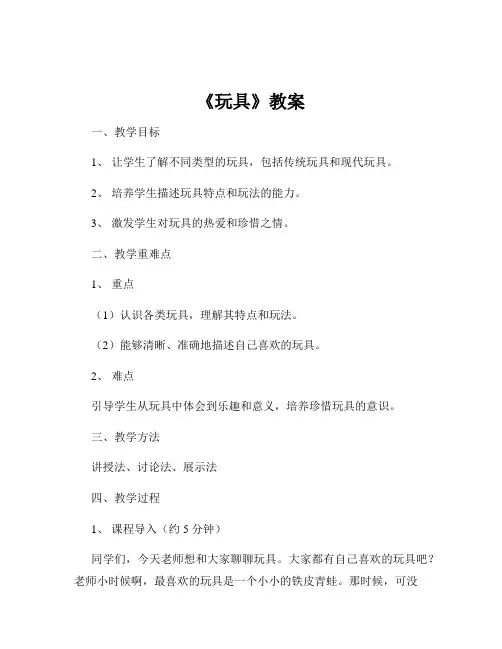
《玩具》教案一、教学目标1、让学生了解不同类型的玩具,包括传统玩具和现代玩具。
2、培养学生描述玩具特点和玩法的能力。
3、激发学生对玩具的热爱和珍惜之情。
二、教学重难点1、重点(1)认识各类玩具,理解其特点和玩法。
(2)能够清晰、准确地描述自己喜欢的玩具。
2、难点引导学生从玩具中体会到乐趣和意义,培养珍惜玩具的意识。
三、教学方法讲授法、讨论法、展示法四、教学过程1、课程导入(约 5 分钟)同学们,今天老师想和大家聊聊玩具。
大家都有自己喜欢的玩具吧?老师小时候啊,最喜欢的玩具是一个小小的铁皮青蛙。
那时候,可没有现在这么多高科技的玩具,但这个铁皮青蛙却给我带来了无尽的欢乐。
它的颜色是那种亮闪闪的绿色,只要拧紧发条,它就能在地上蹦蹦跳跳,可有意思啦!大家也来说说自己最喜欢的玩具是什么吧!2、认识玩具(约 15 分钟)(1)老师通过图片、视频等方式展示各种玩具,如毛绒玩具、积木、拼图、电子玩具等,让学生观察并说出它们的名称和特点。
(2)请同学们分组讨论,分享自己带来的玩具,互相介绍玩具的玩法和乐趣。
3、描述玩具(约 15 分钟)(1)每个小组推选一名代表,上台向全班同学介绍自己小组最喜欢的玩具。
(2)引导学生从玩具的外观、颜色、材质、功能等方面进行描述,锻炼他们的语言表达能力。
4、玩具的意义(约 10 分钟)(1)提问:玩具仅仅是用来玩的吗?(2)引导学生思考玩具在成长过程中的作用,比如可以培养动手能力、想象力、创造力等。
5、珍惜玩具(约 10 分钟)(1)讲述一个故事:有个小朋友得到新玩具后就把旧玩具乱扔,结果旧玩具都伤心地哭了。
(2)让学生讨论:我们应该怎样对待自己的玩具?从而引导学生珍惜玩具,爱护玩具。
6、总结与作业布置(约 5 分钟)(1)总结本节课的内容,强调玩具带来的快乐和我们应该珍惜玩具。
(2)作业:回家后整理自己的玩具,为自己最喜欢的玩具写一篇小短文,描述它的特点和带给自己的快乐。
五、教学反思在这堂课中,通过让学生分享自己的玩具和经历,充分调动了他们的积极性。
(小学教案)玩具教学设计教案:玩具教学设计一、教学内容本节课的教学内容选自人教版小学数学教材一年级下册第三单元《认识物体和几何图形》中的第7课时,具体内容为各种玩具的认识和分类。
二、教学目标1. 让学生通过观察和触摸各种玩具,认识和区分不同的物体和几何图形,培养学生的空间观念。
2. 培养学生学会用简单的语言描述物体的特征,提高学生的语言表达能力。
3. 培养学生学会合作交流,发展学生的团队意识。
三、教学难点与重点重点:让学生认识和区分不同的物体和几何图形。
难点:让学生用简单的语言描述物体的特征。
四、教具与学具准备教具:各种玩具、几何图形卡片、黑板、粉笔。
学具:每个学生准备一些玩具,可以是自己喜欢的玩具或者家里不用的旧玩具。
五、教学过程1. 实践情景引入(5分钟)教师展示一些玩具,如球、汽车、洋娃娃等,让学生观察并说出它们的名字。
然后问学生:“你们有没有发现这些玩具有什么不同?”引导学生思考玩具的分类。
2. 例题讲解(10分钟)教师拿出一些几何图形卡片,如正方形、圆形、三角形等,让学生观察并说出它们的名字。
然后教师将这些卡片与玩具进行组合,如将正方形卡片放在汽车上,圆形卡片放在洋娃娃的脸上等。
引导学生理解几何图形与物体的关系。
3. 随堂练习(10分钟)学生分成小组,每组选择一些玩具,将这些玩具进行分类,并用简单的语言描述每类玩具的特征。
教师巡回指导,给予鼓励和指导。
4. 小组合作(10分钟)学生分组进行合作,用积木或其他玩具设计一个简单的场景,如动物园、家庭等。
要求学生在设计过程中运用所学的物体和几何图形。
教师巡回指导,给予鼓励和指导。
每组学生展示自己的设计作品,并介绍作品的特征和所用物体。
其他学生和教师进行评价,给予鼓励和建议。
六、板书设计板书设计如下:玩具分类物体和几何图形球、汽车圆形、正方形洋娃娃、房子三角形、长方形七、作业设计1. 请学生回家后,与家长一起找出家里不用的旧玩具,进行分类并用简单的语言描述每类玩具的特征。
《玩具》教学设计(精选12篇)《玩具》篇1教学内容:课本第6、7页。
教学目标:1、在已有的生活经验上体会数的意义,感受到数学就在身边。
2、培养学生仔细观察、认真思考自主探索的能力。
3、通过动手操作,使学生会数数、读数、写数,初步体会数序的含义。
教学重点:正确数出物体的个数。
教学难点:正确书写数字。
课前准备:数字卡片、。
教学过程:第一节一、创设情境。
(一)引入。
1、开学这几天,你认识了几个新朋友?能给大家介绍介绍吗?(1)同学之间互相介召、互相说。
(2)指名回答。
2、有认识一位新朋友的吗?谁认识了两位新朋友?有更多的吗?这2个新朋友是谁?3、板书: 1 2 3 4 54、有一位小朋友叫“淘气”,他也认识了一位新朋友“笑笑”。
有一天,“淘气”请“笑笑”到家里做客。
(二)出示主题图。
1、看到这幅图,你想说些什么?2、他们在玩些什么玩具?请你数一数,说一说。
引导学生说出图上的物体数量。
(他们在玩玩具,有5个积木、4辆汽车、3个皮球等等)二、尝试探索。
(一)教师提问:1、你是怎样知道这些物体的数量的?(数出来的)2、你是怎样数的?(一个一个的数、两个两个的数)(二)指名数一数,说一说。
1、小组讨论:你认为怎样数数比较好?为什么?思考:如果有更多的物体,又可以怎样数数呢?(三个三个的数、五个五个的数、十个十个的数……)2、小组合作:数出铅笔盒里文具的个数。
(指名展示,全班交流。
)3、如果你想请你的新朋友到家里做客,你准备怎样做?(1)我准备拿2个洋娃娃请好朋友玩。
(2)我准备拿4辆小汽车请好朋友玩。
(3)我准备拿5把玩具请好朋友玩。
(三)揭示课题。
1、刚才同学们准备了那么多的玩具,你们真是一个好客的小主人。
同时我也听出来了,你们说出了许多数量是1 、2、3、4、5的物体。
这就是我们今天要研究的内容。
2、板书:玩具(1、2、3、4、5)(四)指导书写。
1、我们会数出数量是1、2、3、4、5的物体,这些数该怎么写呢?谁会写 1 ? 2怎么写?2、指名板书。
玩具教学设计(精选16篇)玩具教学设计第1篇【教学目标】1、会认11个字。
2、默读课文,学习关爱父母、关爱他人的好品质。
【教学重点】在自读自悟中受到关爱父母、关心他人的思想教育。
【信息资料】字词卡片、课文插图。
【教学时数】一课时。
【教学流程】〖切入举偶〗1、启发谈话:同学们,你们喜欢玩具吗?你最喜欢的玩具是什么?你是如何得到它的?如果你见到一件自己非常喜欢的玩具,你会怎样做呢?(学生谈话)而今天我们来共同认识一位小朋友,他的做法也许会出乎你的意料。
2、观察说话:出示课文幅图。
引发学生思考:这是什么地方?什么时候?你是怎么看出来的?有什么人?(相机教学生字词“玩具”“柜台”“售货员”),读题设疑:这玩具柜台前的孩子有什么特别的地方吗?(由学生的生活实际引出课文内容,激发学生的好奇心,和读书的欲望。
培养学生的语言表达和观察思维能力。
)〖对话平台〗一、初读1、组织学生自学课文。
划出生字词语,把生字所在句子认真地多几遍。
2、同桌互读,互相纠正读音。
3、全班交流识字方法,说说自己是怎样记住这些字的。
鼓励学生个性化的记字方法。
4、分段指读课文,师生评议正音。
(本课的11个生字只有认读的任务,所以这一环节应成为本课的一个着力点。
鼓励学生个性化的识字记字方法,对于学生自主识字能力的形成是一个有效地促进。
)二、朗读1、自主读第一节,启发思考:这个孩子在玩具柜台前想干什么?你读懂了什么?有什么感受?说说自己的理由。
2、组织学生进行交流,相机指导有感情地朗读。
可以引导学生抓住关键词语深入体会小男孩对玩具汽车的喜欢之情。
如:目不转睛、兴奋的光芒、多么等等。
(从小男孩在玩具柜前的表现入手,抓住人物的外在表现,体会人物的内心世界,为理解下文小男孩的异常决定,体会人物的品质打下坚实基础。
自主讨论的方式,同有感情地朗读相结合,训练了学生对语言文字的感受能力。
)三、讨论1、深入研读课文,分组研究讨论:小男孩那样喜欢小汽车,为什么不买一辆呢?2、教师巡视,引导学生抓住人物的对话进行体会。
《玩具》英语教案:让孩子快乐学习知识Objectives:-To introduce children to the concept of learning through play-To help children develop their cognitive, social, and physical abilities-To teach children new concepts in a fun and interactive wayMaterials:- A variety of age-appropriate toys, such as blocks, dolls, puzzles, and games- A chalkboard or whiteboard-Markers or chalk-Paper and crayonsLesson Procedure:IntroductionBegin the lesson by introducing the concept of learning through play. Explain to children how toys can be used to teach them new concepts and help them develop important skills. Encourage children to be curious and explore the different toys provided.Activity 1: Sorting and CategorizingProvide children with a variety of items such as toy cars, animals, and blocks. Ask them to sort the items based on different criteria, such as color or size. This activityhelps children develop their cognitive skills by teachingthem how to identify similarities and differences.Activity 2: Building with BlocksProvide children with blocks of different sizes and colors. Allow them to build structures using the blocks. This activity helps children develop their physical abilities by improving their hand-eye coordination and fine motor skills.Activity 3: Role-playing with DollsProvide children with dolls and encourage them to engagein role-playing activities. This activity helps children develop their social skills by teaching them how to interact and communicate with others.Activity 4: Solving PuzzlesProvide children with age-appropriate puzzles to solve. This activity helps children develop their cognitive skillsby teaching them problem-solving skills and how to think critically.ConclusionWrap up the lesson by summarizing the differentactivities and discussing the different skills that were developed. Ask children how they feel about using toys to learn new things. Encourage them to continue exploring different toys and finding new ways to learn through play.In conclusion, toys can be a powerful tool for educating children and helping them develop important skills. By using toys in a fun and interactive way, we can make learning an enjoyable experience for children. It is crucial to encourage children to play and explore different toys as this helps to stimulate their imagination and creativity. By doing so we can help them learn new concepts, develop important skills, and build lasting memories from their childhood.。
一、活动背景随着科技的进步和社会的发展,玩具在儿童成长过程中的作用日益凸显。
玩具不仅能够激发儿童的想象力,培养他们的动手能力,还能促进他们的社交能力和认知发展。
本活动旨在通过一系列玩具教学活动,帮助幼儿更好地了解玩具的种类、功能以及如何正确使用玩具。
二、活动目标1. 让幼儿了解不同种类的玩具及其特点。
2. 培养幼儿的动手能力和创造力。
3. 提高幼儿的社交能力和合作意识。
4. 增强幼儿的环保意识。
三、活动准备1. 玩具:木制积木、拼图、塑料玩具、毛绒玩具等。
2. 教学材料:图片、视频、故事书等。
3. 教学工具:白板、投影仪、录音笔等。
四、活动过程(一)导入环节1. 教师出示各种玩具,引导幼儿观察并说出玩具的名称。
2. 提问:你们知道这些玩具是用来做什么的吗?它们有什么特点?(二)教学内容1. 木制积木:介绍积木的种类、颜色、形状,以及如何搭建简单的建筑。
2. 拼图:讲解拼图的规则,引导幼儿进行拼图游戏,培养他们的耐心和细心。
3. 塑料玩具:展示塑料玩具的种类,如汽车、飞机、动物等,引导幼儿了解它们的功能和特点。
4. 毛绒玩具:讲述毛绒玩具的来历和特点,培养幼儿的爱心和关爱。
(三)实践环节1. 分组活动:将幼儿分成若干小组,每组选择一种玩具进行实践操作。
2. 每组派代表向其他小组展示他们的作品,并分享制作过程中的心得体会。
(四)总结环节1. 教师对本次活动进行总结,强调玩具的重要性。
2. 鼓励幼儿在日常生活中多与家人、朋友分享玩具,培养良好的社交习惯。
3. 提醒幼儿注意玩具的环保问题,提倡使用环保玩具。
五、活动延伸1. 家长配合:鼓励家长在家庭中为幼儿提供更多种类的玩具,并引导他们正确使用玩具。
2. 社会实践:组织幼儿参观玩具工厂,了解玩具的制作过程。
3. 主题活动:定期举办玩具展览,让幼儿展示自己的作品,提高他们的自信心。
六、活动评价1. 观察幼儿在活动中的参与程度,了解他们对玩具的认知程度。
2. 通过实践环节,评估幼儿的动手能力和创造力。
《【教学设计《玩具》】玩具教学设计》摘要:生2:这个男同学有2只手、2只脚、2只眼睛,都可以用2来表示,生1:1可以表示1朵花、1只鸡、1枝钢笔、1群人,(同桌互相检查) 师:1个娃娃、1张卡片可以用数字几来表示呢? 生:可以用数字1来表示〖教学目标〗1.能正确数出5以内的数,能运用数表示日常生活中的一些事物,并进行交流,会写1~5这几个数。
2.使学生初步感受数学与生活的联系及学习数学的愉悦,培养学生正确的握笔姿势和写字姿势,使学生养成良好的学习习惯。
〖教材分析〗本课以儿童喜爱的玩具导入,并通过“数玩具”情境来培养学生学习数学的兴趣,使学生能正确数出5以内物体的个数,并会写1~5这几个数。
教学时,教师可引导学生自己数一数、说一说,自主地进行学习交流。
对刚入学的学生来说,写数可能有一定的困难,教师可以适当给予示范。
学生书写时,教师要多加指导,随时纠正学生的握笔姿势和写字姿势,使学生从小养成良好的学习习惯。
不要求学生一次写得太多,可以在以后的练习中逐步达到整齐、匀称、熟练。
对学生的点滴进步要及时地给予鼓励。
〖学校及学生状况分析〗我校是自治区示范学校,条件较好,有现代化的多媒体教室;学生都来自城市,而且都上过幼儿园,大部分学生会数数和写数,对数学学习兴趣浓厚,上课时敢想、敢说、敢问,思维活跃,但也有一部分学生写数的时候笔顺不正确,有些学生的字不规范,不会按格子写。
〖教学设计〗(一)活动一:数一数,说一说师:小朋友们喜欢玩具吗?你们都喜欢哪些玩具呢? (学生都兴奋起来) 生1:我喜欢小汽车。
生2:我喜欢洋娃娃。
……电脑出示第6页的主题图:小红和小明正在玩玩具,你会数一数这些玩具吗?学生打开课本第6页,同桌之间互相说一说。
学生反馈:图上有4辆小汽车、3个皮球、1个娃娃、2个小朋友和5块积木。
根据学生的回答,老师操作课件逐一闪烁学生所说的物体,并小结:4辆汽车可以用4来表示……师:找一找这幅图中还有什么可以用1,2,3,4,5这几个数来表示的? 生1:一辆小汽车有4个轮子,可以用4来表示。
玩具教学设计(Toy teaching design)According to the teaching goal.1. can correctly count the number of less than 5, can use the number to express some things in daily life, and exchange, will write 1~5 of these numbers.2. make the students feel and learning mathematics and life enjoyment, cultivating students' correct writing posture and writing posture, enable students to develop good study habits.On the analysis of teaching materials.The children's favorite toys are introduced, and through the "number of toys" situation to cultivate students' interest in learning mathematics, so that students can correctly count the number of objects within 5, and will write 1~5 of these numbers.When teaching, teachers can guide students to their own count, say, autonomous learning exchanges. For the students who have just entered the school, the number of writing may have some difficulties, teachers can give appropriate demonstration. Students, teachers should be more guidance, corrects students' writing posture and writing posture, make students form good learning habits from childhood. Students are not required to write too much at once, so they can gradually become neat, well proportioned and skilled in their later practice. The students should be encouraged in time.On the analysis of status of schools and students.Our school is the school, the autonomous region with better conditions, the modernization of the multimedia classroom; students are from the city, and all went to kindergarten, count and write most of the students, the learning interest in mathematics class is strong, dare to speak, dare, active thinking, but also have a part of the students to write the number the order is not correct, some students' words are not standardized, not to write checks.According to the teaching design.(a) a: count, sayTeacher: do children like toys? What toys do you like?(all the students are excited)Student 1: I like cars.Student 2: I like dolls.......Computer show sixth page theme: Alice and Bob is playing with the toy, you can count these toys? The students open the books on page sixth, at each other and say.Student feedback: there are 4 cars, 3 balls, 1 dolls, 2 children and 5 blocks on the map.According to the student's answer, the teacher uses thecourseware to flash the objects that students say, and summarizes: 4 cars can be expressed by 4......Teacher: find out what else can be used in this picture, such as 1, 2, 3, 4, 5Sheng 1: a car has 4 wheels, which can be expressed in 4.Sheng 2: this boy has 2 hands, 2 feet, 2 eyes, can be expressed in 2.......Teacher: what other objects in your life can be represented by 1, 2, 3, 4, 5?.Collective feedback.The raw 1:1 can represent 1 flowers, 1 chickens, 1 pens, and 1 groups of people.Sheng 2: there are 1 chickens, 2 ducklings, 3 puppies, 4 small birds, 5 small white rabbits.......(two) activity two: PendulumTeacher: the 1 dolls, 1 flowers and 1 groups of people can say 1, so we can put a triangle to represent 1. What kind of figure can you use to represent it?Sheng 1: you can use 1 squares to represent it.Sheng 2: you can also use 1 circles to represent it.Please use a set of cards to set a pendulum. (desk checks each other)Teacher: 1 dolls, 1 cards can be represented by digital years? Students: can be used to represent the number 1. (division in grid in writing "1")Teacher: then 2 kids, 2 hands, 2 eyes can also use graphics to represent what? (students with learning card with swinging) 2 squares, 2 cards can be represented by the number of Gilead?(2 for mathematics).Please put the pendulum with 3, 4 and 5. (writing on the blackboard)(three) activity three: writeTeacher: the children are very good,Now, if you look at these numbers, will you write? (please) write the number in your book, which number you write, and which one you write.Students try to write, take 5 students' works to show on the projector, the whole class review, inductive writing.Teacher: now the children put the book in a digital scanning grid line scanning, then write in the blank form. Which child can write as well as the book, and after the writing, the deskmate reviews each other.(students Matt in the book of practice, teachers guide students to pay attention to the writing posture tour hall and posture. )The whole class displays the work, once again guides the student to make the appraisal.Summary: the division of the children for the first time to write numbers can write so well, the teacher is really admire you, if kids pay more attention to holding the pen position at the time of writing, they will write better.(four) activity four: practice and Practice1. number of writing (Textbook seventh pages first questions).Teacher: Xiaoming home to the guests, Xiaoming and red took a lot of fruit to entertain guests, you know how many of these fruits are? Will you please count the number of objects, and then think about what figures, write it in the form of. (born independently)Teacher: what do you mean by the three pictures in the second row? What's the number 1 in the box in the first picture?Student: each picture has 5 squares in the Delta, "1" colour Delta 1.Teacher: ask the children to write the numbers in the squares of the two pictures behind.(born independently)Teacher: now, if you look at the numbers of the second rows of the three figures, what are the rules?Sheng 1: they are singular numbers.2: from the left, the number is more and more big, and every time 2.Sheng 3: from right to left, each time less than 2, smaller and smaller.2. see the line of drawing (seventh pages, second questions).Teachers help students understand the digital is a few draw out a few round.(living independently and communicating with each other)3. experience ordinal number (Textbook seventh pages third questions).Teacher: what we said 1, 2, 3, 4, 5 are all used to indicate the number of objects. Now, let's look at the numbers on the carriage. What do they mean?Teacher: how many carriages are there? What animals are there on the carriage?Student: there are 5 carriages altogether. The tiger, monkey, squirrels, elephants and pandas on the car.Teacher: the tiger's carriage says "1". What does it mean?Student: the tiger is in the first carriage.Teacher: Yes, here is the 1 first day, then the little squirrel in the first few cars? Monkey, elephants and pandas and in the first few car? Would you please fill in the boxes.(born independently, at the same table exchange)4. games.The teacher clapped, listen to the applause to write.Play games with deskmate. A high five, a number of people to write.Teacher's summary: today we learned 1~5 of the writing style, the children wrote very seriously, the next time we will hold a writing contest, together to pick up our class of small calligrapher". "Teaching reflection"The whole class designed four activities to achieve the teaching goal, the number of toys is low grade children the love and familiar, I selected the students interested in, befamiliar with the material, mobilize the enthusiasm of the students, so that they are learning is an interesting thing. Let the students to be transformed the number of objects for specific graphics to express the abstract digital graphics, through the transformation of intuitive operation -- Graphical symbols - digital sign ", so that students understand the significance of the number in the actual situation in the.Mathematics is the science of pattern, finding and discovering the relationship between things and the changing rules of things constitute the important content of mathematics learning. At the same time, it is found that the process of relationship and law is also the process of developing students' exploration ability.So I put this "law discovery" with the daily teaching activities, such as let the children in the exercises of the first questions the second row of the figure, find out the requirements of the subject and to find permutations in numbers. The students can also find the problems in the third question in view of the requirements, fill in the box number, also can spontaneously to find the arrangement of the digital.In addition, the children said: "in life and what objects can also use 1, 2, 3, 4, 5 said," there is a child to say "1 people", that I had not thought of it, children's potential is not to be underestimated."The case review.The research shows that: students recognize digital symbolswill go through three processes, intuitive operation - Graphical symbols - Digital symbols. This case is to follow the result of this study, we designed the following two activities: "count, say" this activity from the students are familiar with the living situation and the interest of the toy, so that students can understand the significance of the number in the actual situation, in the activities of middle school mathematics, in the life of middle school mathematics, experience mathematics originates from the life; "swinging, write" provides hands-on opportunities for students, let the students of intense interest operation, the abstract numbers into a live action, a number of specific objects will be transformed for graphical representations, and the reality of the students, let the students on the graphics again, abstraction, and thus a better understanding of the digital symbol. The whole teaching activities follow the students' age characteristics and cognitive laws, and promote the development of students' inquiry ability step by step. The teacher put the students as the main body of the study, provides the opportunity for students to explore independently, guide students to study independently and explore actively, experience the joy of success, to stimulate students' interest in learning, so that students feel mathematics useful and interesting.The 2012-2013 school year, Beijing Normal University edition on the first grade mathematics teaching planFirst, the characteristics of this textbook:1. Close the connection between mathematics and the real world.The textbook "basic narrative patterns to form the problem situation -- Model: Interpretation and application", so that students starting from the life experience and objective facts, and developing mathematics learning mathematics, understanding in the study of the reality of the. At the same time, in real life, students can be exposed to a wide range of modern mathematical world, such as number, quantity, space, graphics, possibility, relation, algorithm, etc..2, establish the students in the main position of mathematics learning. The knowledge, thought and method of mathematics must be understood and developed by students in the practical mathematics practice, rather than relying solely on the teacher's explanation. The new textbook provides a large number of opportunities for observation, operation, experiment and independent thinking, and then obtains the mathematical conclusion through the discussion and exchange of the learners. Such a curriculum system has created a good curriculum environment for the establishment of the learner's dominant position.3, establish exploratory learning methods, cultivate students' innovative consciousness. The textbook focuses on the exploration of the problem, the theme is rich and colorful, the presentation of information is diverse and selective, and the strategy of solving the problem is diversified, the answer is not unique...... All these are trying to make students form exploratory learning as soon as possible, develop innovative consciousness and innovation ability.Two. Analysis of students' situation:Just enter the first grade primary school from kindergarten children, innocent and lovely, all the schools are curious, the change from the "game" to "learning", allowing them to "learn" it is, especially in the fresh after, also with a pressure on learning. They have children's loose and active nature, and they have strong plasticity. Most of these children are very wealthy family, home is very fond of, develop their willful, selfish, spoiled, self and some bad habits. Their preschool education is uneven, and they have different degrees of mastery of the mathematical knowledge, but the overall level is general, the polarization is obvious, there are individual children even some simple addition and subtraction method will not.The experience of collecting, sorting, describing and analyzing data.Emotions, attitudes, values:1, initially feel the connection between mathematics and life, as well as the joy of learning mathematics. To actively participate in vivid and intuitive mathematical activities, under the encouragement and help of others, we can overcome some difficulties encountered in mathematical activities, gain successful experience, and have the confidence to learn mathematics well.2, in the process of training students good learning habits. Cultivate the spirit of active exploration and the sense of cooperation with students.3, preliminary training students in a certain order of observation habits. Develop students' ability to observe, imagine, and express language.4, through the combination of students daily schedule, cultivate students' attitude to cherish the time and reasonable arrangement of good habits of time5, with the help of interesting and real situations, stimulate students' interest in participating in statistical activities and train students' preliminary statistical consciousness.Four, improve teaching, improve the quality of measures:1. Develop good study habits. The regular training and training of students' learning is the prerequisite to ensure the quality of teaching. From the placement of learning supplies, how to listen, how to write, how to remember homework, as well as a simple method of checking homework, are the content of learning habits. In class, we should take step by step approach, and gradually guide students to think independently, dare to ask questions, listen carefully to other people's opinions, and be willing to express their ideas and other intrinsic learning quality. Through the study of this semester, to establish a good beginning, in the future study should pay full attention to the formation of good learning habits of students, this goal throughout the whole process of teaching. W w w.X K B 1.c o m2, create a lively and interesting learning situation. According to the "standard" to adjust the teaching content, for students to learn mathematics to provide more knowledge.Students entering school, everything is very strange, teaching is to pay attention to according to the age characteristics of children, some children interested in design process, such as games, stories, games, look for the material from the life, let the students feel a sense of mathematics, stimulate their interest in learning mathematics. The physiological and psychological characteristics between the real life of students and children pay attention to teaching, loved by students in the game, fairy tales, stories, cartoons and other forms, to enrich the students' emotional accumulation, development of number sense of students and the preliminary conception of space. By providing specific learning situation, the design of interesting mathematics activities, encourage each student to start, move, mouth, brain, participate in the process of mathematics learning.3, combined with students' actual teaching. The individual differences of the new students are relatively large, and some students may have some simple mathematical knowledge in different degrees. Therefore, in the teaching process, according to the actual situation of students, the content and progress of teaching materials should be adjusted properly, and create interesting and interesting learning activities to promote the development of students. Teachers should organize teaching from the development of students and the specific needs, not only concerns the individual, but also does not affect the whole.4, pay attention to students' experience and experience, according to the existing experience and knowledge of students, design activities and learning materials. Such as teachingaddition and subtraction within 10, most children have to calculate addition and subtraction within 10, but can not put it clearly expressed, so when teaching emphasis will be placed on training children verbal ability, let them to speak; improve the calculation speed of children. Pay attention to the understanding of students' logarithmic concept, let students understand the number can be used to express and exchange, the initial establishment of sense of number. The calculation teaching reflects the diversification of the algorithm, allowing students to use their own appropriate method of calculation.5, doing exercises and writing homework is the necessary link to consolidate knowledge and acquire skills in mathematics classroom teaching. (1) find out the difficulties students should help in time, stimulate interest in various forms. (2) actively develop students' interest in learning, and cultivate their desire to learn mathematics by using context. (3) encourage students to ask questions, speak more, praise them in good time, and use the medal system to set up examples of class learning,Combined with the class evaluation system to form a good learning atmosphere.Five 、 teaching schedule and chapter plan.。